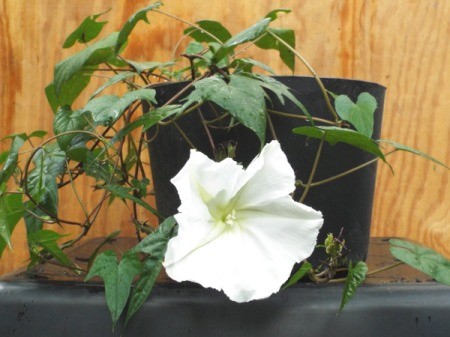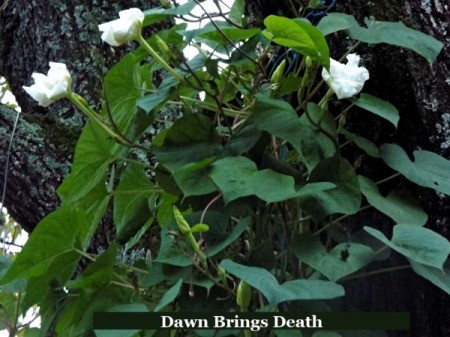
 I've had moonflower vines climb my trees and attain a height of 50 feet. A lot of people who appreciate this flower may not grow them for that reason. Some may not have any structure for the vines to climb.
I've had moonflower vines climb my trees and attain a height of 50 feet. A lot of people who appreciate this flower may not grow them for that reason. Some may not have any structure for the vines to climb.
I have good news for those people. It may be common knowledge to many gardeners, but new to me is the fact that the vine will grow quite well, and bloom, in a container. It just occurred to me that they should do well on a trellis of 6 feet or so. I say that because once the vine has reached the desired height, it can be pruned. Cutting back the new, long runners seems to force the vine to produce even more blooms.
If you have been hesitant to grow the moonflower vine because of the heights it can reach, do know it can be kept in a container and it's ultimate height can be whatever you choose. Imagine having a pot of these on your patio, covered in blooms, and filling the air with it's heady fragrance.


Add your voice! Click below to comment. ThriftyFun is powered by your wisdom!
Across the pond here in the UK this vine looks like our dreaded Bindweed. Once you have it in your garden it is impossible to get rid of. It is called Bindweed over here because it binds around other plants in the garden,strangles and kills them, if you ever cut it back, make sure you get every little piece.
The bindweed is classified as Convolvulaceae.
The Moonflower vine is classified as Ipomoea (Ipomoea alba).
Two different plants, entirely.
Looks can be deceiving, can't they?
Actually, bindweed and morning glory are common names applying to many members of the family Convolvulaceae. This family contains, among many others, the genera Convolvulus and Ipomoea.
Cousins is a good word. Does it fall into the category of Bindweed? Depends on where you live. Is it invasive? In most parts of the world, No. Is it poisonous? You will find many accounts on the Internet saying, Yes.
It has been documented that the seeds and leaves are eaten in some parts of the world. I have eaten the flowers and suffered no ill effects. It may be considered an invasive bindweed in the UK, I don't know. Here in the US, only three states have declared it an invasive weed.
Add your voice! Click below to comment. ThriftyFun is powered by your wisdom!